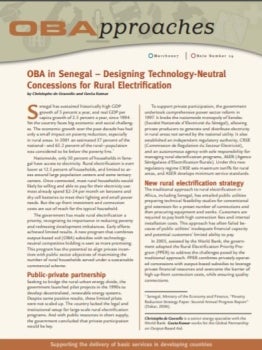OBA in Senegal: Designing Technology-Neutral Concessions for Rural Electrification
-

Sector
-

Country
Region
-

Year Published
2007

Nationwide, only 30 percent of households in Senegal have access to electricity. Rural electrification is even lower at 12.5 percent of households, and limited to areas around large population centers and some tertiary centers. Once connected, most rural households would likely be willing and able to pay for their electricity use: most already spend $2–24 per month on kerosene and dry cell batteries to meet their lighting and small power needs. But the up-front investment and connection costs are out of reach for the typical household. The government has made rural electrification a priority, recognizing its importance in reducing poverty and redressing development imbalances. Early efforts achieved limited results. A new program that combines output-based aid (OBA) subsidies with technology-neutral competitive bidding is seen as more promising. This program has the potential to align private incentives with public sector objectives of maximizing the number of rural households served under a sustainable commercial scheme.

